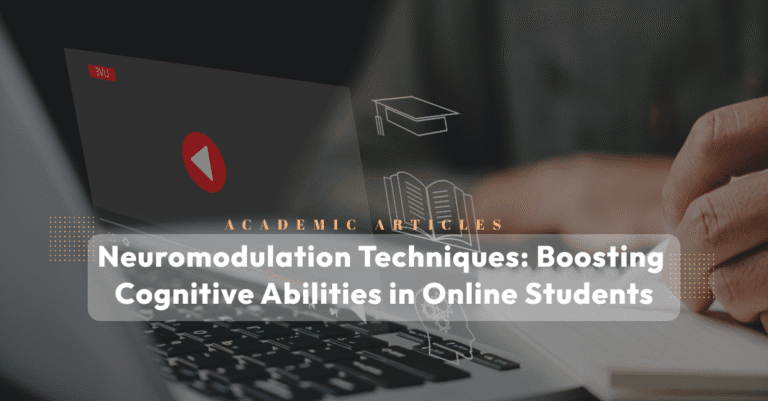Neuromodulation refers to non-invasive ways of nudging brain circuits with tiny electrical (or magnetic) currents so they fire a little more—or a little less—readily. The most widely studied form is transcranial direct-current stimulation (tDCS), where 1–2 mA of current is delivered through two sponge electrodes on the scalp for 10–30 minutes.
Because the current is far below the threshold needed to make neurons fire, it acts more like a gentle primer, making practice or tutoring that follows “stick” more efficiently.
Other emerging cousins include transcranial alternating-current stimulation (tACS), which oscillates the current at specific frequencies to entrain brain rhythms, and transcranial random-noise stimulation (tRNS), which adds broadband “neural dither” that can sharpen signal detection in learning tasks.
Meta-analyses now show small-to-moderate gains in working memory, numerical skills and response inhibition in healthy participants, with effects often persisting for weeks when stimulation is paired with structured practice.
What does the latest research actually say?

Key research findings on tDCS include:
- Working-memory boost – Ten sessions of tDCS paired with memory games produced a medium-sized gain in accuracy and reaction time that lasted one month (healthy young adults);
- Numerical learning – A single right-parietal tDCS session followed by four days of home practice sped up number–space mapping in 9- to 12-year-olds;
- ADHD attention training – Multichannel tDCS over the left prefrontal cortex improved visual attention and inhibitory control in 66 adolescents (12-17 yrs) with no serious adverse events;
- Remote, at-home delivery – A 10-week, video-supervised tDCS protocol with 210 adults showed high adherence and safety, proving that fully remote use is feasible.
These gains are not magic bolts of “super-intelligence.” Rather, stimulation seems to amplify the learning curve when it is paired with the right practice task and delivered on a consistent schedule.
Is it safe for children?
- Tolerability: Large datasets covering 1 000 + paediatric sessions report only mild, transient scalp tingling or redness. Serious adverse events are exceedingly rare.
- Guidelines: The Limited Output Transcranial Electrical Stimulation 2023 (LOTES-2023) update recommends child-specific dose limits (≤20 min, ≤1 mA, maximum of 20 sessions per cycle) and mandatory adult supervision.
- Ethics: All protocols still require parental informed consent, medical screening for epilepsy risk, and independent safety monitoring.
Bottom line: Early data are reassuring, but schools must treat tDCS as investigational and follow clinical-grade oversight.
Other scalable neuromodulation tools
- tACS – Aligns brainwaves (e.g., theta 5 Hz for working memory); systematic reviews show modest but reliable cognitive gains in healthy adults;
- tRNS – Adds high-frequency “neural noise” that sharpens signal-to-noise ratios; when paired with math games, it improves calculation speed in children with learning difficulties;
- Neurofeedback – Lets students up-regulate helpful EEG rhythms via game-like interfaces; meta-analyses report small-to-moderate attention gains, especially in ADHD, with no external current.
Implementation roadmap for K-12 schools
- Immediate (0–6 months) – Embed adaptive working-memory or mental-rotation games in the LMS to create a solid cognitive-training base before adding hardware.
- Pilot phase (6–18 months) – Run a small, opt-in pilot (tDCS/tRNS) with a university or certified neuromod clinic; include medical oversight, parent webinars, and pre-/post-testing to generate internal safety and efficacy data.
- Scale-up (18–36 months) – Offer a “neuromod-ready” study kit (CE-marked headset, electrode sponges, Bluetooth lockbox) that unlocks only when a trained facilitator on Zoom confirms electrode placement, ensuring uniform dose control.
- Curricular integration – Time-specific montages with demanding units (e.g., left-prefrontal anodal tDCS before intensive reading comprehension; parietal montages during geometry) so stimulation targets the most relevant neural circuits.
- Safeguards & equity – Provide clear opt-out options, accommodate students with contraindications, and subsidize headsets via education-savings accounts (ESAs) so the program remains inclusive and legally compliant.
Key takeaways for administrators and parents
- tDCS is an amplification, not a shortcut. Benefits emerge only when combined with high-quality teaching and deliberate practice.
- Safety comes first. Follow LOTES-2023 dose limits, enforce remote supervision, and maintain a standing physician advisory board.
- Start small, measure, iterate. Treat every rollout as an A/B experiment with clear cognitive and academic endpoints.
- Parallel tracks matter. Even if stimulation ultimately proves marginal, the cognitive-training infrastructure you build will still pay dividends.
- Ethics and transparency win trust. Publish your pilot data (good or bad) and keep parents in the loop.
The road ahead
Within five years, low-cost, app-controlled stimulators could be as common in study spaces as noise-cancelling headphones. By moving early—but cautiously—online schools can position themselves at the forefront of evidence-based cognitive enrichment, offering students not just flexible schedules and global classrooms but scientifically tuned “brain gyms” that make every hour of study count.
Neuromodulation is no silver bullet, but used wisely, it can become a powerful force multiplier for digital education, lighting up the neural pathways that help young minds thrive.
Share, Discuss, or Ask
Do you have a child in an online school, or are you considering enrolling your child in one? We’d love to hear about your experiences. Let us know what has been or may be decisive in the dilemma of traditional vs. online.
If you have questions, please visit us at EduWW or email [email protected].



